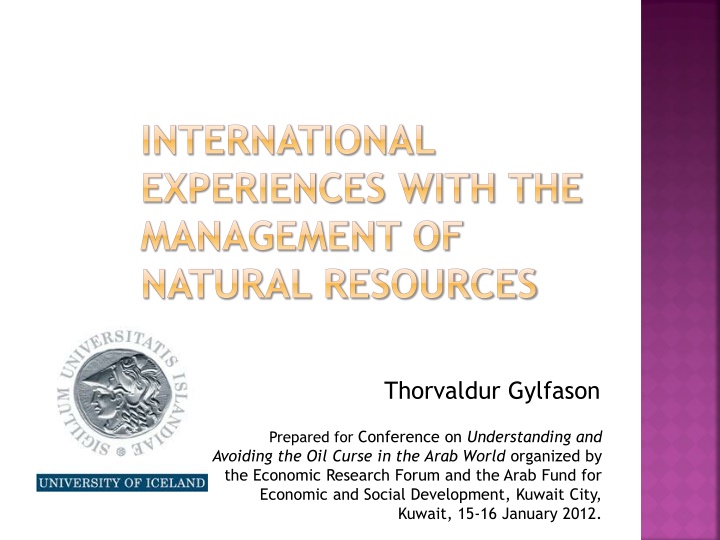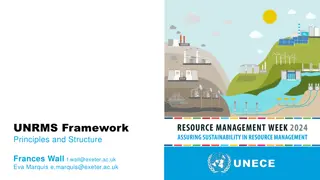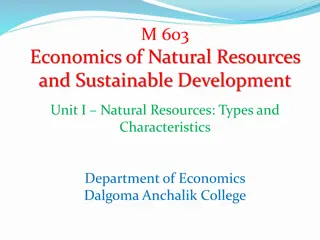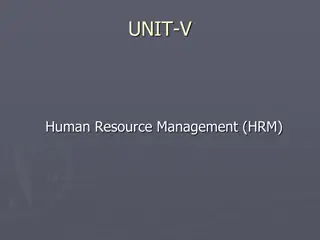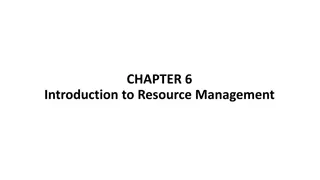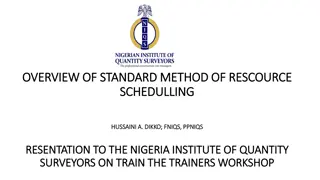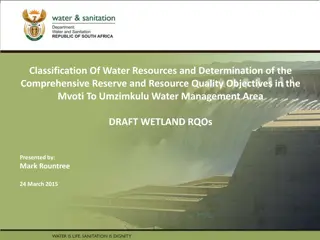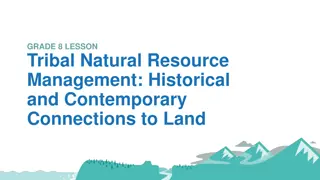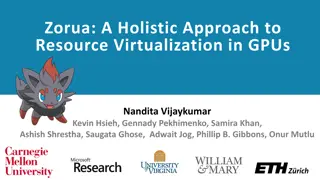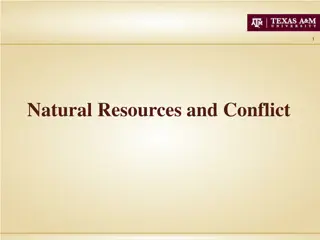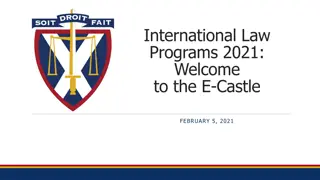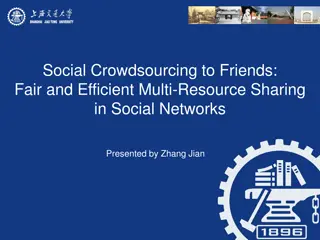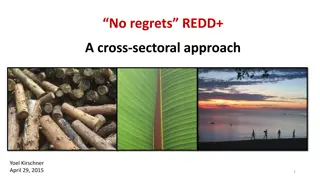International Experiences with Natural Resource Management
"Explore insights on managing natural resources from international perspectives, highlighting the shift from valuing physical to human and social capital for sustainable growth. Learn from global examples and policy considerations for economic development and wealth creation."
Download Presentation

Please find below an Image/Link to download the presentation.
The content on the website is provided AS IS for your information and personal use only. It may not be sold, licensed, or shared on other websites without obtaining consent from the author.If you encounter any issues during the download, it is possible that the publisher has removed the file from their server.
You are allowed to download the files provided on this website for personal or commercial use, subject to the condition that they are used lawfully. All files are the property of their respective owners.
The content on the website is provided AS IS for your information and personal use only. It may not be sold, licensed, or shared on other websites without obtaining consent from the author.
E N D
Presentation Transcript
INTERNATIONAL EXPERIENCES WITH THE MANAGEMENT OF NATURAL RESOURCES Thorvaldur Gylfason Prepared for Conference on Understanding and Avoiding the Oil Curse in the Arab World organized by the Economic Research Forum and the Arab Fund for Economic and Social Development, Kuwait City, Kuwait, 15-16 January 2012.
Photograph:Vladimir Putin, 2005. OLD ECONOMIC GEOGRAPHY Assigned key role to natural resource wealth and raw materials Tended to equate those resources with economic strength Yet, many resource-abundant countries are poor, while several resource-poor countries are rich Prime Minister Putin of Russia: Our country is rich, but our people are poor.
COMPOSITION OF WORLDS NATIONAL WEALTH National wealth Intangible capital Physical capital Natural capital
SHARE OF NATURAL CAPITAL IN TOTAL TANGIBLE CAPITAL
NEW ECONOMIC GEOGRAPHY Recognizes several different sources of wealth, emphasizing human capital and, increasingly, social capital Social capital refers, among other things, to governance and institutions Many resource-rich countries have fared badly, while several resource- poor countries have done well There are many kinds of capital and many different sources of growth
FROM NATURAL RESOURCES TO HUMAN CAPITAL Listen to Lee Kwan Yew, founding father of Singapore (1959-1991): I thought then that wealth depended mainly on the possession of territory and natural resources, whether fertile land ..., or valuable minerals, or oil and gas. It was only after I had been in office for some years that I recognized ... that the decisive factors were the people, their natural abilities, education and training.
OVERVIEW: THREE PARTS 1. Sources of growth with different types of capital 2. Selected policy issues concerning the contribution of natural resources to economic growth around the world 3. Lessons from Norway Keys to success Relevance for Near East and Africa
SOURCES OF GROWTH 1. Saving and investment Real capital 2. Education, health care Human capital 3. Exports and imports Foreign capital 4. Democracy and freedom Social capital 5. Stability Financial capital 6. Diversification away from Natural capital
SOURCES OF GROWTH 1. Saving and investment Real capital 2. Education, health care Human capital 3. Exports and imports Foreign capital 4. Democracy and freedom Social capital 5. Stability Financial capital 6. Diversification away from Natural capital
DIFFERENT KINDS OF CAPITAL AND GROWTH Social capital Corruption Democracy Human capital Education Fertility Financial capital Inflation Real capital Investment Natural capital Growth
NATURAL CAPITAL AND OTHER KINDS OF CAPITAL Education Finance Corruption Natural capital Investment Democracy
ECONOMIC GROWTH AND NATURAL CAPITAL 1960-2000 8 Growth of per capita GDP, adjusted for 6 4 initial income (% per year) 2 0 -0.2 0.0 0.2 0.4 0.6 0.8 1.0 -2 -4 -6 -8 -10 Natural capital as share of total wealth
NATURAL RESOURCES: A MIXED BLESSING? Listen to King Faisal of Saudi Arabia (1964-1975): In one generation we went from riding camels to riding Cadillacs. The way we are wasting money, I fear the next generation will be riding camels again.
POLICY ISSUES IN RESOURCE RICH COUNTRIES Four main areas 1. Fiscal policy 2. Monetary, financial, and exchange- rate policy and the Dutch disease 3. Institutions and governance 4. Diversification Economic, away from excessive dependence on a few natural resources Political, away from narrowly based power elites
FISCAL GOVERNANCE Natural resource wealth is an efficient tax base because resource taxation causes minimal distortions to economic behavior Case in point: Iceland s missed opportunity Could have auctioned off catch quotas and used proceeds to abolish personal income taxes Chose instead to allocate fishing quotas to boat owners free of charge, in a discriminatory fashion Then chose to privatize its banks the same way, and they all collapsed a few years later in 2008 Important to reduce other less efficient taxes to keep overall tax burden reasonable Also, spend tax receipts efficiently
FISCAL RULES Price stabilization funds Build up reserves when commodity prices are high Use up reserves when prices are low Aim is to shield producers from price fluctuations Subject to similar reservations as stabilization policies Example from Chile Government can run a deficit larger than the target of zero, or 1% surplus, to the extent that Output falls short of potential, or Price of copper is below its medium-term (10-year) equilibrium Two panels of independent experts determine the output gap and the medium-term equilibrium price of copper
DUTCH DISEASE: HOW OIL EXPORTS CROWD OUT NONOIL EXPORTS Real exchange rate Imports C B A Exports with oil Exports without oil Foreign exchange
DUTCH DISEASE: DISEASE OR NOT? Term refers to fears of de-industrialization that gripped the Netherlands following appreciation of Dutch guilder after discovery of natural gas deposits in North Sea around 1960 Is it a disease? Some say No, viewing it simply as matter of one sector s benefiting at the expense of others, without seeing any macroeconomic or social damage done Others say Yes, viewing the Dutch disease as an ailment, pointing to the potentially harmful consequences of the resulting reallocation of resources from high-tech, high-skill intensive service industries to low-tech, low-skill intensive primary production, for example for economic growth and diversification
DUTCH DISEASE: DIFFERENT MANIFESTATIONS Overvaluation of currency damages other exports and import-competing industries Rent seeking diverts resources from other more socially productive activities Volatility of commodity prices leads to volatility in output, thereby slowing down economic growth
DUTCH DISEASE: DIFFERENT MANIFESTATIONS Overvaluation of currency hurts other exports and import-competing industries Norway s total exports were long stagnant in proportion to GDP following oil discoveries Oil exports crowded out nonoil exports Nokia is Finnish, LM Ericsson is Swedish, B&O is Danish Norway s almost unique unwillingness to join EU Keeping inflation low to avoid overvaluation Price stability requires good monetary governance through independent yet accountable central banks Healthy financial sector development also requires good monetary governance, including transparency
DUTCH DISEASE: DIFFERENT MANIFESTATIONS Rent seeking Especially in conjunction with ill-defined property rights, imperfect or missing markets, and lax legal structures tends to divert resources away from more socially fruitful economic activity International initiatives to raise transparency Extractive Industries Transparency Initiative (EITI) aims to set global standard for transparency in oil, gas and mining Revenue Watch Institute (RWI) promotes responsible management of oil, gas, and mineral resources Natural Resource Charter (NRC) sets out principles for how to manage natural resources for development
GOOD POLICIES MATTER Fiscal policies need to foster efficient revenue collection as well as efficient, growth-friendly public spending To be efficient and fair, the utilization of natural resources requires that the owners the people be appropriately compensated Property rights to natural resources belong the people by international law Article 1 of the International Covenant on Civil and Political Rights states that All people may, for their own ends, freely dispose of their natural wealth and resources (Wenar, 2008) Kuwait Constitution, Article 21: Natural resources and all revenues therefrom are the property of the State Monetary policies need to avert overvaluation and excessive volatility of the currency
GOOD INSTITUTIONS AND GOVERNANCE ALSO MATTER Consider Norway From day one, Norway s oil and gas reserves were defined by law as common property resources, clearly establishing the legal rights of the Norwegian people to the resource rents On this legal basis, the government has absorbed about 80% of the resource rent over the years Government laid down economic as well as ethical principles ( commandments ) to guide the use and exploitation of the oil and gas for the benefit of current and future generations of Norwegians
GOOD INSTITUTIONS AND GOVERNANCE Norway was a well-functioning, full-fledged democracy long before its oil discoveries Democrats are less likely than dictators to try to grab resources to consolidate their political power Elsewhere, point resources such as oil and minerals have proved particularly lootable Petroleum industry has conferred sizable spillover benefits on others at home and abroad through transfer of technology as well as research and development
SUCCESS STORIES How Botswana succeeded Started out at independence in 1966 with 12 km of paved roads, 22 college graduates, and 100 secondary-school graduates Diamonds, discovered in 1967, provide tax revenue equivalent to 33% of GDP Sub-Saharan Africa s highest per capita GNI Good policies, good institutions, democracy How Mauritius succeeded Emphasized trade and education in lieu of sugar Cosmopolitan population Again, good policies, good institutions, democracy Let s look at some numbers
BOTSWANA AND DIAMONDS -6 14000 12000 Botswana 10000 Congo, Dem. Rep. 8000 Sierra Leone 6000 4000 6 2000 0 1 Per Capita GNI (USD at PPP)
BOTSWANA AND DIAMONDS -6 14000 10 7 8 12000 -2 Botswana 6 10000 Botswana Congo, Dem. Rep. 4 8000 Sierra Leone Sierra Leone 2 6000 0 4000 -2 6 2000 -4 0 1 -6 -8 Per Capita GNI (USD at PPP) Democracy
BOTSWANA AND DIAMONDS -6 14000 8 7 12000 Botswana 6 10000 Congo, Dem. Rep. 5 8000 Sierra Leone 4 6000 3 Botswana 4000 2 Sierra Leone 6 2000 1 0 1 0 Per Capita GNI (USD at PPP) Fertility
MAURITIUS AND SUGAR 14000 Costa Rica 7 12000 Fiji 6 10000 Mauritius 8000 6000 5 4000 2000 0 Per Capita GNI (USD at PPP)
MAURITIUS AND SUGAR 14000 12 10 Costa Rica 7 10 12000 10 Fiji 6 8 10000 Mauritius 6 8000 4 Costa Rica Fiji Mauritius 6000 2 5 4000 0 2000 -2 0 4 -4 -6 Per Capita GNI (USD at PPP) Democracy
MAURITIUS AND SUGAR 14000 8 Costa Rica Costa Rica 7 7 12000 Fiji Fiji 6 6 10000 Mauritius Mauritius 5 8000 4 6000 3 5 4000 2 2000 1 0 0 Per Capita GNI (USD at PPP) Fertility
NORWAY AND OIL 70000 5 Algeria 60000 Norway 50000 Saudi Arabia 40000 12 30000 20000 10000 13 0 Per Capita GNI (USD at PPP)
NORWAY AND OIL 12 70000 5 10 Algeria 10 60000 8 Norway Algeria 50000 6 Norway Saudi Arabia 4 40000 Saudi Arabia -4 2 12 30000 0 -2 20000 -4 10000 13 -6 -8 0 -10 -10 -12 Per Capita GNI (USD at PPP) Democracy
NORWAY AND OIL 70000 8 5 Algeria 7 60000 Norway 6 50000 Algeria Saudi Arabia 5 40000 Norway 4 12 Saudi Arabia 30000 3 20000 2 10000 13 1 0 0 Per Capita GNI (USD at PPP) Fertility
NORWAY: NOT JUST OIL The problem is not the existence of natural wealth as such ... but rather the failure to avert the dangers that accompany the gifts of nature Norway is, so far, a success story Government invests 80% of oil rent entirely in foreign securities 60% in equities 40% in fixed-income securities
NORWAY: NOT JUST OIL Norway always had its natural resources It was only with the advent of educated labor that it became possible for the Norwegians to harness those resources on a significant scale Human capital accumulation was the primary force behind the economic transformation of Norway Natural capital was secondary
OIL FUND, NOW PENSION FUND The purpose of the oil fund Share the wealth fairly: Pension fund Shield domestic economy from overheating and possible waste Fund has grown huge: USD 450 billion That makes almost USD 100K per person Norwegians have resisted temptation to use too much of the money to meet current needs
GOOD INSTITUTIONS AND GOVERNANCE Long tradition of democracy and market economy in Norway since before the advent of oil Large-scale rent seeking was averted as oil was, by law, defined as a common- property resource from the beginning Adequate investment performance Excellent education record Female college enrolment doubled from 46% of each cohort in 1991 to 94% in 2006
GOOD TIMES DEMAND STRONG DISCIPLINE Natural resources bring risks A false sense of security leads people to underrate or overlook the need for good policies and institutions, good education, and good investment Awash in easy cash, they may find that hard choices perhaps can be avoided Awareness of these risks is perhaps the best insurance policy against them
OLD STORY: THE RISKS ARE REAL David Landes (1998) tells the story of Spain following the colonization of South and Central America which made Spain rich in gold and other natural resources: THE END Easy money is bad for you. It represents short-run gain that will be paid for in immediate distortions and later regrets.
